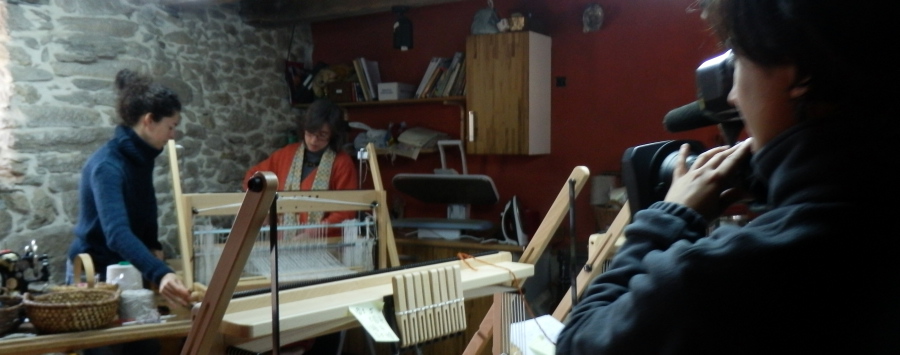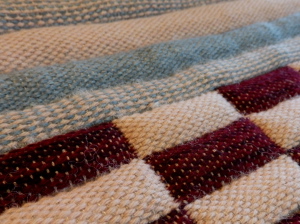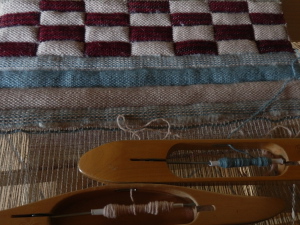¿Te interesa realizar un curso online de tècnicas del tejido en telar con Anna Champeney?Si te interesa aprender técnicas de diseño y tejido en telar de bajo lizo online, escríbanos y suscribir a nuestro boletín.
 Contacta con nosotros |  Today I analysed this cushion design by the Welsh weaving mill Melin Trygwynt. It´s a particularly pleasing, geometric design and the mill produce the design as cushions, blankets and other products in wool. Today I analysed this cushion design by the Welsh weaving mill Melin Trygwynt. It´s a particularly pleasing, geometric design and the mill produce the design as cushions, blankets and other products in wool.
Below you can see the fabric window view of my weave software which I used to “discover” the “formula” behind the pattern.  It has been an interesting exercise to analyse the design and see how it was woven. You learn a lot from this process. In theory I could weave a design which uses the same colours and type of yarn and the result would be similar to the Melin Trygwynt piece, but it would be questionable to do this from an ethical viewpoint. When there is so much scope for creating original design why imitate or copy someone elses? It´s often because of a lack of knowledge and skill. It has been an interesting exercise to analyse the design and see how it was woven. You learn a lot from this process. In theory I could weave a design which uses the same colours and type of yarn and the result would be similar to the Melin Trygwynt piece, but it would be questionable to do this from an ethical viewpoint. When there is so much scope for creating original design why imitate or copy someone elses? It´s often because of a lack of knowledge and skill.
From a personal viewpoint, the idea of copying designs just doesn´t interest me and never has. For this reason I find the idea of using pattern books as ready-made design sources quite boring. I am also reluctant to tell my students exactly how pieces are woven – because I´m far more interested in showing them the principles behind the design so they can go on to create original designs themselves. It takes a long time and experience to start to master this though, probably a lifetime. I am more interested in learning about how patterns work and how woven structure and colour can work together in original and interesting ways in order to develop my own style. Sampling using standard patterns is a useful first step, although even then I always introduce elements of my own and use that as a springboard. But increasingly the idea for the design comes first and then I look for ways to translate it into a woven textile. Ths leads me on to suggesting that small-scale, high-end independent fashion designers in Spain can also approach the issue of fabric in a different and more interesting way. I am sometimes approached by young designers wishing me to weave fabric by hand. I have yet to meet a designer who is actually aware of the work involved and the time a craftsperson needs to work on an entirely new weave project and most projects founder because the designer hasn´t realised just how time-consuming it is to create a bespoke textile. Designers often lament how little craftspeople know about design, and often they have a point. But designers are also pretty ignorant about how craftspeople work and see them simply as suppliers of labour and have a lot to learn as well. A textile designer contacted me only last week to ask me if I could wave a short length of fabric for a prototype range of clothing using a very classic, simple pattern. The idea was interesting in principle and I suggested that the classic design could be updated and given a contemporary twist rather than weaving the existing, standard design. Because I understand how structure and pattern works I know how to adapt a classic style and give it an original touch or flavour, adding value and interest to the final garment design. I´m not really that interested, as a hand-weaver, in replicating standard, classic designs; hand-weaving is an incredibly time-consuming process so if you´re going to commission some expensive hand-made, limited-edition fabric then the quality and appropiateness of the design is fundamental. But if weavers in Spain don´t develop these these design skills or knowledge of how to adapt classic designs they are limited to copying standard designs and this can only lead to dull, stagant design. This is quite common. In fact classic designs have always been re-worked in fashion because they are so successful, but they do need to be adapted as tastes evolve. My own view is that to keep a competitive edge requires innovation rather than replication. And this depends on skill and creativity and the ability to develop one´s own style. And although it takes time, it´s a lot more satisfying than copying or weaving traditional patterns.    These charming mini-catalan baskets are ideal presents for your young kids or grandchildren – so they can harvest fruit and veg from the garden or even help mum and dad with the shopping! These charming mini-catalan baskets are ideal presents for your young kids or grandchildren – so they can harvest fruit and veg from the garden or even help mum and dad with the shopping!
Mini baskets include versions similar to the traditional Catalan mushrooming basket, the double “potato peeling” (pelapatas) basket. But Lluis will also be displaying a full-size bres basket, beloved of collectors but also still made to commission as a traditional basketry cradle. And unlike other models of cradle, the bres can also be used for storing toys and other things later on. You can visit Lluis Grau at his stand at the Fira del Cistell en Salt, Gerona, on Saturday 6 y Sunday 7 October 2012. Girona, the city which has grown to absorb the town of Salt, has great transport links with its international airport and a visit to the fair can make the central point of a fun weekend break away, with typical catalan music, dancing, a display of the scary “human towers” or “castells” and other attractions. But be warned – there is always a tempting array of baskets on exhbition so bring a large bag with you! Lluis´ new basketry book – Lluis also hopes to be able to have copies of his new book available for sale at the fair. The book, co-authored by Anna Champeney and published by the Basketmakers´ Association with financial assistance from the Worshipful Company of Basketmakers, is about the very attractive wooden basketry tradition of Los Ancares in Galicia, north Spain. Another treat for basket lovers, this book includes a practical section on how to make these wonderfully elegant split wood baskets.
- Where: The old quarter of Salt, Girona
- When: Primer fin de semana de octubre – 6 y 7 de octubre 2012.
- Products: Baskets from Spain and internationally
- Featured basketmaker: Lluis Grau
- Web: www.lluisgrau.com
- Contact: T.669 600 620.
Next basketry course with Lluis Grau at his workshop in rural northwest Spain (nearest train station: Monforte de Lemos) 3 & 4 November – Beginners´ basketry in willow More information – contact Lluis via email
 Anna Champeney (r) with weave pupil Ana Roman (l) being filmed by Televisión Gallega for the regional magazine programme "Great Places"
Yesterday and today the habitual tranquility and silence of the picturesque Galician hamlet of Cristosende was broken as the village was taken over by the film crew of TVG for the making of Grandes Lugares (Great Places), a regional magazine programme. Yesterday a good number of us villagers turned up at the old school, to share a glass of local wine, some empanada (traditional pie), and bread with a selection of cheeses and village-made chorizo and salchichón sausage, and explain to the film crew exactly what makes the village so special for us. Is it the fact that the village has a stunning view over some of the most dramatic scenery in the Ribeira Sacra area of north Spain? Or that, in a village of only about 30 inhabitants, there are no fewer than 3 local businesses – the craft workshops with Casa dos Artesans holiday cottage, the Casa Grande rural hotel and bar, and Pepe´s bodega, Viña Perderneira. Or is it simply the fact that the village has a pretty good atmosphere, with neighbours always willing to help each other out? This morning the film crew came to Anna Champeney Estudio Textil and Lluis Grau´s basketry workshop to conduct interviews, both with the local craftspeople themselves and Ana Roman, a weave student who explained how satisfying it was to weave her own soft alpaca scarf on a loom – and how relaxing it is too (except, of course, when 5 members of a film crew are filming you!). Well, we´re not going to tell you anything else for now, but will post up the video link when we know the date of emission, and invite you to watch – and meet all our neighbours here in Cristosende.
Padded doubleweave textiles – Doubleweave tuition option now available – Weaving holidays for intermediate level weavers in Spain
 Photo of padded double weave fabric (Anna Champeney Estudio Textil Spain))
 Weaving "quilted" fabrics with 2 shuttles on a Louet table loom
Giving an interview whilst weaving doubleweave with two shuttles is no easy task – it´s like trying to whistle and hum at the same time (and I only know one person who can do that!), so the TV crew had to wait and watch a little until the moment came to stop weaving and insert the stuffing into the “pockets” and “tubes” created by the double weave! Weaving textiles on the loom in two layers opens the door to lots of magical and seemingly impossible options – from weaving a textile which is actually wider than the loom you are using to weaving a tube, to weaving two layers of fabric which intersect to create pockets – which can be filled with filling which gives you an effect rather like a quilted textile. Applications? Double weave is great for scarves and (using very fine yarns) for clothing fabrics which are really warm and insulating but which can still drape nicely, without feeling not lumpy or thick. But the thick quilted-effect double weave fabrics can also be used for thick padded jackets, cushion pads, bedcovers and upholstery fabrics. The only limit is your imagination. Anna Champeney and Lluis Grau offer one-to-one tuition in their craft workshops and looms for hire to guests staying at their holiday cottage, Casa dos Artesans. Their availability as tutors in 2012 is already limited so you are advised to reserve the cottage and any tuition well in advance. Contact.
|
Pago seguro
 NUEVO Octubre 2023 Curso presencial setmanal de teixits de baix lliç (Girona)!Un curso nou, setmanal (3h) a Sant Gregori, Girona, amb l'Anna Champeney. Trimensual, plaças limitadas).
Octobre 2023. Ven a aprender a diseñar y realizar tejidos en telar de bajo lizo a mano. Docente: Anna Champeney, profesional desde 2004, con marca textil propia, experta en tejido de bajo lizo, docente en la Escola Massana, Barcelona.
 Haga clic aquí para informarte |
 Today I analysed this cushion design by the Welsh weaving mill Melin Trygwynt. It´s a particularly pleasing, geometric design and the mill produce the design as cushions, blankets and other products in wool.
Today I analysed this cushion design by the Welsh weaving mill Melin Trygwynt. It´s a particularly pleasing, geometric design and the mill produce the design as cushions, blankets and other products in wool. It has been an interesting exercise to analyse the design and see how it was woven. You learn a lot from this process. In theory I could weave a design which uses the same colours and type of yarn and the result would be similar to the Melin Trygwynt piece, but it would be questionable to do this from an ethical viewpoint. When there is so much scope for creating original design why imitate or copy someone elses? It´s often because of a lack of knowledge and skill.
It has been an interesting exercise to analyse the design and see how it was woven. You learn a lot from this process. In theory I could weave a design which uses the same colours and type of yarn and the result would be similar to the Melin Trygwynt piece, but it would be questionable to do this from an ethical viewpoint. When there is so much scope for creating original design why imitate or copy someone elses? It´s often because of a lack of knowledge and skill.










